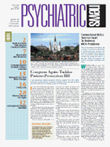From February 21 to 25, I attended the American College of Psychiatrists’ scientific meeting in Tucson. The members of the college are generally well known and largely from the academic community. Self-designated clinicians constitute about 10 percent of the membership. There are about 800 members from the United States, about 30 members from Canada, and 20 members from other international locations. Most of the members know each other because of the college’s relatively small size and because they often interact in other settings such as the American Board of Psychiatry and Neurology examinations. Spouses and significant others usually attend the meetings. This makes for a closeness and family feeling seldom achieved in larger organizations.
The college’s scientific programs are consistently excellent and allow enough free time to enjoy and explore the setting. The theme of the program this year was “Educating Psychiatrists for the 21st Century.” Jim Shore began his lecture with a quotation, “The trouble with the future is that it arrives before we are ready for it.” After noting psychiatry’s unique rise from eighth to second in NIH funding in less than a decade, Jim presented an interesting survey of the ACP membership in which the members rank ordered the items from most important to least important. The highest-ranked item was funding from industry, presumably the pharmaceutical industry. Patient care also received high marks. One of the lowest-ranked items was clinical reimbursement. Internal medicine, pediatrics, and obstetrics were ranked ahead of psychiatry. APA was ranked about one-fourth from the bottom, with the AMA at the bottom. I present these data to you, because I believe a survey of the APA membership would result in a different rank order, and it is important to be aware of the differing perspectives in our field. To me it was remarkable that academic psychiatrists ranked their own field below many others.
Joseph Coyle began with a quotation as well. It went something like this: “A pessimist is an optimist who has been confronted by all of the facts.” Joe noted that despite major scientific advances, there has been a steady erosion of support for psychiatry departments from academic medical centers. He cited the Hay Group study in which the health care benefits for psychiatric care were reduced 54 percent under behavioral managed health care, while the benefits for all health care were reduced 7 percent under managed care. When as little as 1 percent of the health care dollar is devoted to psychiatric care, psychiatry programs cannot operate at a profit. Psychiatry is standing out as a major loss of financial resources in academic medical centers even when the psychiatric patient census is 100 percent. At Harvard, the funds for psychiatry departments have decreased by 60 percent in the past five years. Deans complain that departments of psychiatry are not up to the standards of other departments, especially those that are procedurally oriented, because they don’t generate much profit. Yet, students rate psychiatry departments highly, and the departments generate the largest amount of funding for research. Although Dr. Coyle believes the future of psychiatry is bright, he stated, “Until colleagues attribute as much value to fixing a broken mind as they do to fixing a broken bone, the problems of departments of psychiatry will continue.”
Other portions of the program focused on psychiatric disorders and the teaching and use of psychotherapy. Psychopharmacology researchers presented data on anxiety disorders and depression, documenting that patients improve about equally with either medication or psychotherapy, but that the combination of the two treatments results in a much greater improvement. Moreover, while medication may have an earlier effect, the patient’s improvement deteriorates on medication alone. Also, psychoanalytic psychotherapy appears to be important in the treatment of borderline personality disorder. From other presentations I was surprised to learn that there has never been a national study to determine the prevalence of child abuse and that evidence of predisposition to schizophrenia is detectable in fetuses.
This meeting provided a rich learning experience, excellent socialization, and a better appreciation of what takes place in academia. Clearly, we must do more to convince our medical colleagues of psychiatry’s value. ▪

